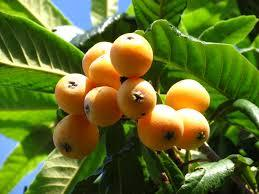 Succulent, tangy yet sweet, wonderfully delicious loquat fruit is rich in vitamins, minerals, and anti-oxidants. This unique fruit originated in the wild, evergreen rainforests of Southeastern China, from where it spread across the world including Japan. Some of the common names of loquat include Japanese plum, Japanese medlar, Maltese plum, etc.
Succulent, tangy yet sweet, wonderfully delicious loquat fruit is rich in vitamins, minerals, and anti-oxidants. This unique fruit originated in the wild, evergreen rainforests of Southeastern China, from where it spread across the world including Japan. Some of the common names of loquat include Japanese plum, Japanese medlar, Maltese plum, etc.
Loquat plant can be described as an evergreen, large shrub or small tree belonging to the family of Rosaceae, in the genus; Eriobotrya. The botanical name is Eriobotrya japonica and closely related to the “apples.”
Loquat fruits begin appearing in the trees by the end of winter season. Mature fruits can be ready to harvest by June in Japan; however, their harvesting season may vary from region to region. The fruits are oval to pear in shape, appear in bunches of 5-20, and measure about 3 cm in width and 3-5 cm in length.
In general, the fruits can ripen on the tree itself before harvesting. Ripe fruits have a soft texture. Externally, its yellow to orange color skin is fuzzy but smooth. Internally, the flesh is either white or golden yellow depending on the cultivar type. Each fruit contains 3-5, centrally placed large, brown seeds. Seeds are inedible and may carry toxic cyanogen-glycosides.
Being a member of Rosaceae family of fruits, loquats have similar taste and flavor as that of apples; tart, and sweet with a pleasant aroma. However, they are soft and juicy in texture instead of crispy as in apples. Loquat’s leaves also employed in traditional medicines, and as herbal tea in many parts of the world.
Health Benefits of Loquat fruit
- Delicious, loquats carry lower calories; provide just 47 calories per 100 g. Nonetheless, they are rich in insoluble dietary fiber, pectin. Pectin holds back moisture inside the colon, and thus functions as bulk laxative. This way, it helps protect the colon mucosa by cutting exposure time of toxic substances as well as binding to cancer-causing chemicals in the colon.
- Pectin has also been shown to reduce blood cholesterol levels by lowering its reabsorption in the colon through binding bile acids, resulting in its excretion from the body.
- Loquat fruit is an excellent source of vitamin-A (provides about 1528 IU or 51% of daily recommended levels of this vitamin per 100g), and phenolic flavonoid antioxidants such as chlorogenic acid, neo-chlorogenic acid, hydroxybenzoic acid, feruloyl quinic acid, protocatechuic acid, epicatechin, coumaric acids and ferulic acid. Ripe fruits have more chlorogenic acid concentrations.
- Vitamin-A helps maintain the integrity of mucosa and skin. Lab studies suggest that consumption of natural fruits rich in vitamin-A, and flavonoids may offer protection from lung and oral cavity cancers.
- Fresh fruit is good in potassium and some B-complex vitamins such as folates, vitamin B-6 and niacin and contain small amounts of vitamin-C. Potassium is an important component of cell and body fluids that helps to regulate heart rate and blood pressure.
- Furthermore, the fruit is also an excellent source of iron, copper, calcium, manganese, and other minerals. The body uses manganese as a co-factor for the antioxidant enzyme, superoxide dismutase. Copper is essential in the production of red blood cells. Iron is required for as a cofactor in cellular oxidation as well in red blood cell formation.
Selection and storage
Loquat fruit season begins by June in Japan. Generally, the fruits can be ready for harvesting once their skin turns yellow and flesh becomes soft. Ripe fruits should be carefully picked up from the bunch and handled to avoid damage.
In the store, buy fresh ripe fruits featuring bright yellow color; smooth surface and impart mild yet sweet aroma. They should be devoid of any wrinkles, cuts, and patches on the skin. Avoid any overtly soften fruits with spots as they tend to perish early.
Loquats keep well for up to two weeks in the fruit/vegetable compartment of the home refrigerator.
Preparation and serving methods
Wash loquats in cold water before consuming to remove any surface dirt or pesticide residues.
Its flesh just underneath the skin is rather sweeter than its central tart pulp. Skin can be peeled easily. Peeled fruits are eaten fresh or may be mixed with other fruits like banana, mango, and orange sections in salads.
Here are some serving tips:
- Loquat Fruit sections are a great addition to fruit salads.
- They also used in desserts or as a pie filling or chopped and cooked to prepare a sauce.
- Loquat fruit is also made into jam, jelly and poached in sugar syrup with cinnamon to make delicious loquat fruit syrup.
【Reference】https://www.nutrition-and-you.com/loquat-fruit.html






